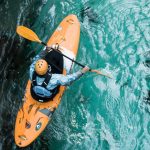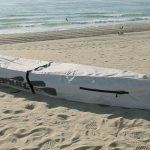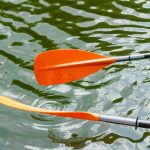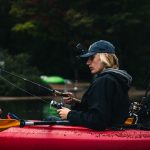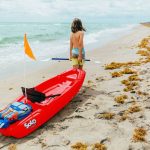In this article, we’ve reviewed our top picks for beginner whitewater kayaks. You’ll also find a comprehensive guide to help you decide which one is best for you.
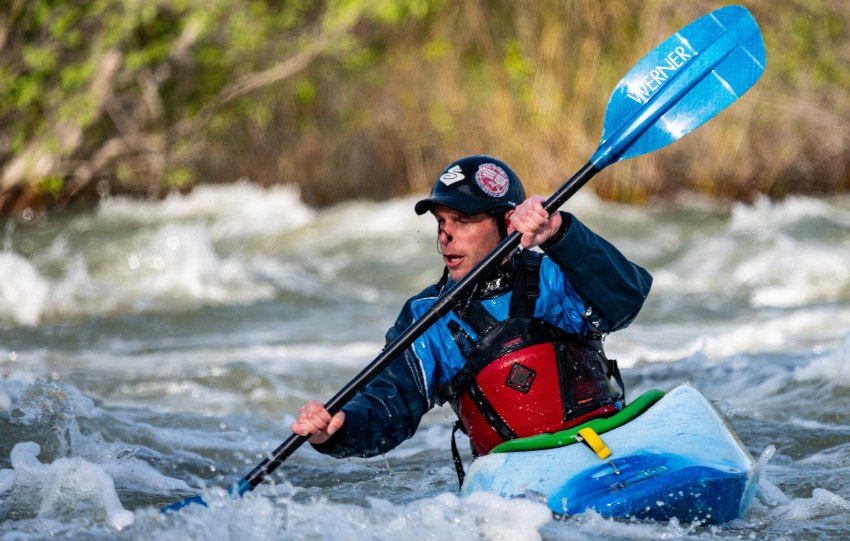
The right whitewater kayak paddle can make the difference between making a difficult move and missing a stroke. Shopping for something so personal might feel quite difficult and you may not know where to start.
We’ve selected some of the best whitewater paddles and outlined some factors to think about before you buy.
Your paddle should feel like an extension of your body. It is your direct line to the water. You feel the movement through it and make decisions based on the feedback you get from your hands.
You need the perfect paddle and that paddle has to be right for you. Many paddlers are more protective of their paddle than they are of their boat. It’s personal.
As an affiliate of Amazon and other retailers, we may earn a small commission when you buy via our links, at no additional cost to you. Thank you!
Quick Answer: Best Whitewater Kayak Paddles
- Aqua-Bound Shred
- Werner Rio
- Werner Strike
- Werner Sherpa
- Werner Sho-Gun
- Werner Side Kick
- Werner Surge
- Werner Stikine
Best Whitewater Kayak Paddles
Aqua-Bound Shred
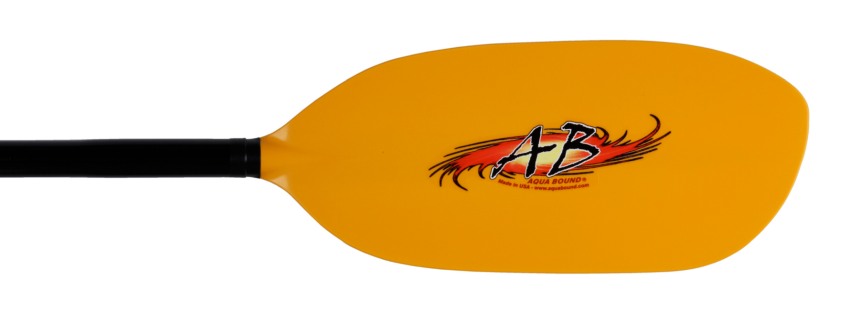
Blade size: 117 sq. in. / 755 sq. cm.
Blade dimensions: 7.75 x 18 in. / 20 x 46 cm
Fiberglass 1-piece, Fiberglass 4-piece
Lengths: 192 cm / 194 cm / 196 cm / 198 cm / 200 cm
Weight: 38.5 oz. / 1091 g
Ferrule Options: 0°, 15°, 30°, 45°, 60°, right-handed or left-handed
Blade material: fiberglass reinforced nylon
Shaft material: fiberglass
Hybrid 1-piece, Hybrid 4-piece
Lengths: 192 cm / 194 cm / 196 cm / 198 cm / 200 cm
Weight: 36.5 oz. / 1035 g
Ferrule Options: 0°, 15°, 30°, 45°, 60°, right-handed or left-handed
Blade material: fiberglass reinforced nylon
Shaft material: Carbon
Carbon 1-piece, Carbon 4-piece
Lengths: 192 cm / 194 cm / 196 cm / 198 cm / 200 cm
Weight: 34.5 oz. / 978 g
Ferrule Options: 0°, 15°, 30°, 45°, 60°, right-handed or left-handed
Blade material: Carbon reinforced nylon
Shaft material: Carbon
Apart
Lengths: 210 cm / 220 cm / 230 cm / 240 cm
Weight: 40 oz. / 1134 g (kayak paddle). 26 oz. / 737 g (each canoe paddle). 50 oz / 1417 g (whole system).
Blade material: Carbon reinforced nylon
Shaft material: Carbon
Whether you’re starting out in white water, or looking to hone your skills on the river, Aqua-Bound Shred range has a paddle for you. The whole range is designed around solid nylon blades, with either fiberglass or carbon reinforcement. This robustness gives you a paddle which endures even the most abusive river runs.
The high angle blades of the Shred are designed to be used with an upright paddle stroke, producing maximum power and performing intricate strokes. The extra stiffness of the carbon reinforced blades will make these finite strokes and the power phase of the stroke slightly more efficient.
The shaft options are similar to the majority of Aqua Bound’s range, with the Shred available with either an aluminium or carbon shaft. These are all available in either one, or four pieces, depending on how transportable you require your paddle to be.
The Shred Apart option is something that’s a little different. This was designed alongside Alpacka Raft, the pack-rafting experts. The Apart comes with the same base model as the four piece Shred, but it also comes with two T-grip sections, giving you a high quality kayak paddle which can convert into two canoe paddles. With one paddle, you can either use your packraft solo, or as a tandem pair.
Werner Rio
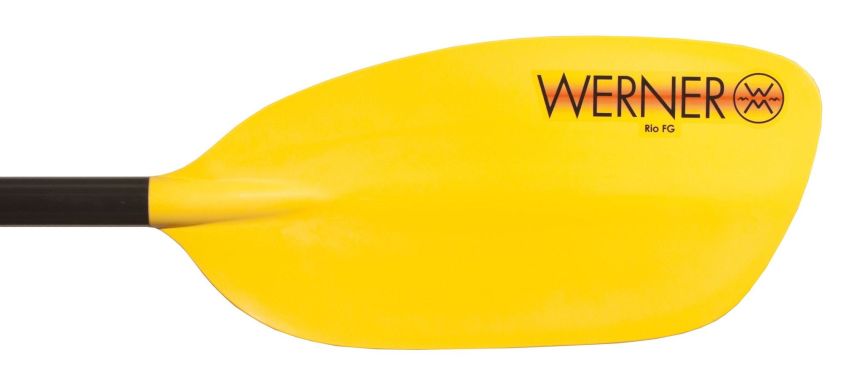
Blade size: 101 sq. in. / 655 sq. cm
Blade measurements: 41 x 19.5 cm / 16 x 7.6 in.
Blade material: fiberglass reinforced nylon
1-piece straight shaft
Lengths: 191 cm / 194 cm / 197 cm / 200 cm
Weight: 37.75 oz. / 1070 g
Feather angles: 30° right-handed / 45° right-handed
2-piece straight shaft
Lengths: 200 cm / 210 cm / 220 cm
Weight: 41.5 oz. / 1176 g
Feather angles: 30° right and left-handed / 45° right and left-handed and 0°
4-piece straight shaft
Lengths: 194 cm / 197 cm / 200 cm / 203 cm / 206 cm / 209 cm
Weight: 43.75 oz / 1240 g
Feather angles: 30° right and left-handed / 45° right and left-handed and 0°
Dependable, robust river running paddles at an affordable price, Werner Rio are among the most popular beginner white water paddles on the market. These paddles are no frills, but the fiberglass reinforced, nylon blades give you minimal flutter and smooth power transition.
They might be entry level, in terms of Werner paddles, but if you bear in mind that Werner have been making industry leading white water paddles for decades, there’s a lot of technology in a budget paddle.
The Werner Rio is a popular favorite with kayak schools, for their robustness and progression. With their range of sizes and shaft options, they make a great spare paddle too, where you need a dependable set of splits in the back of your boat, without breaking the bank for something you hope not to use too regularly.
Werner Strike
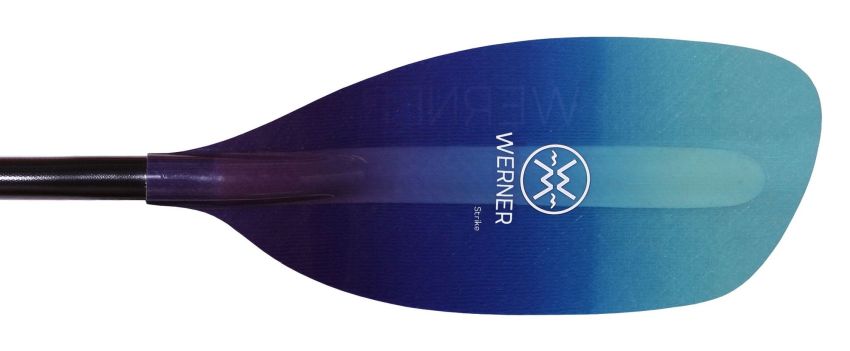
Shaft Material: Fiberglass
Shaft Options: Straight shaft, 30° or 45° right handed. Standard or small shaft options. Bent shaft available at extra cost.
Blade Material: Fiberglass
Blade Dimensions: 7.75 x 18 in. (19.5 x 46.5 cm)
Blade Size: 106 sq. in. (685 sq. cm)
Lengths: 191 / 194 / 197 / 200 / 203 cm
Weight: 34.75 oz. (985 g)
Werner enjoyed a great success with their Twist, their performance paddle aimed at smaller paddlers, it was great but had a very high angle, direct and powerful blade. Now, with the Strike, there’s a paddle aimed at smaller paddlers which has the same flow for linking strokes as Werner’s ever popular Sherpa (next on the list, unsurprisingly).
The Strike’s blades are designed to be smooth to pull through the water, as well as easy to recover and catch quickly for the next stroke, all without that ‘tug’ that sometimes comes from longer paddles.
With fiberglass shaft and blades, these are stiff and responsive, without the bank-breaking expense of carbon. This also means you won’t be too upset if you bounce off a few rocks along the way.
You can get this paddle in a standard shaft, or a small shaft if it fits your hands better. This is important for white water, where grip and feedback through the paddle allow you to intuitively make your next move on the river. A poor fitting shaft will really hamper your performance when it counts.
Werner Sherpa
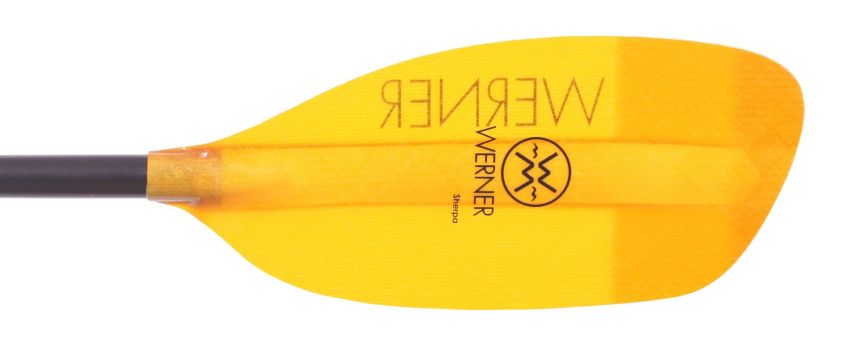
Blade size: 105 sq. in. / 680 sq. cm.
Blade measurements: 18 x 7.5 in. / 46 x 19.5 cm
Blade material: fiberglass
1-piece straight shaft
Lengths: 191 cm / 194 cm / 197 cm / 200 cm
Weight: 34.75 oz. / 985 g
Feather angles: 30° right-handed / 45° right-handed
4-piece straight shaft
Lengths: 194 cm / 197 cm / 200 cm / 203 cm / 206 cm / 209 cm
Weight: 40.75 oz. / 1155 g
Feather angles: 30° right and left-handed / 45° right and left-handed and 0°
1-piece bent shaft
Lengths: 191 cm / 194 cm / 197 cm / 200 cm
Weight: 37.25 oz. / 1056 g
Feather angles: 30° right-handed / 45° right-handed
The sherpas that work around the Himalayas have been an integral part of many of the most enterprising white water expeditions. These trips have changed the face of white water for generations to come. Reliable, solid and exactly what you want in a tricky situation, the Werner Sherpas are aptly named after these incredible peoples.
The Sherpa paddles are smooth as they come. Whether you’re pushing the grade, or on your favorite local run, the effortless catch and release on the Sherpa allow you to fluidly link powerful strokes together. These are the perfect paddle for making the moves where they matter most.
If you’re a larger paddler, or are looking for a little more power without negotiating on smoothness, the Powerhouse blades are the Sherpa’s larger sibling in Werner’s product line.
Werner Sho-Gun
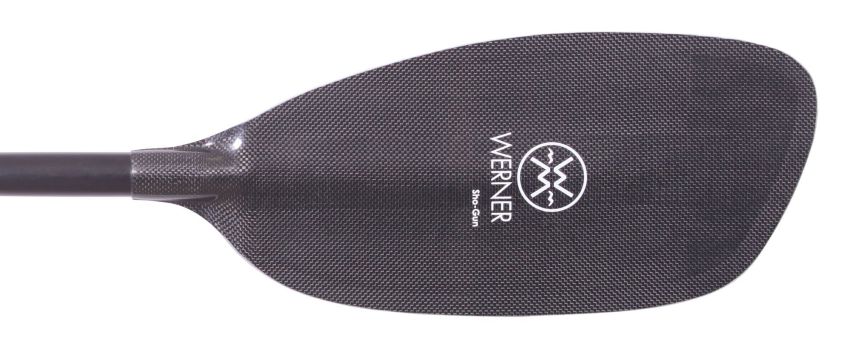
Shaft Material: Carbon
Shaft Options: Straight shaft, 30° or 45° right handed. Standard or small shaft options. Bent shaft available at extra cost.
Blade Material: Carbon, foam core. Dynel® edges and Kevlar® reinforcement on the blades.
Blade Dimensions: 7.85 x 18.85 in. (20 x 48 cm)
Blade Size: 100 sq. in. (711 sq. cm)
Lengths: 194 / 197 / 200 / 203 / 206 cm
Weight: 36 oz. (1021 g)
Sometimes you want to know you’ve got the best of the best, a paddle which provides unsurpassed power and performance from a stiff, responsive package which is hard to beat. The Sho-Gun is just that, sitting alongside the Double Diamond and the Stikine.
These high angle blades are designed to give direct power exactly when you need it. The power to weight ratio is heightened by the foam core in the blades, which is also a great asset if you need to roll, as your paddle already wants to float to the surface.
The drawback to carbon, other than the eye watering price, is that if you plan to rock bash your way down a river, you’re going to get pretty upset as small pieces of your paddle are chipped off along the way. Werner have gone some way to negate this by reinforcing the blades, especially the edges, but this is still a paddle for deeper rivers and making tight, technical moves, rather than for scraping down a low water run.
There’s loads of options with regard to the shaft diameters and whether you want it bent or straight, but whatever you choose, you’re getting an enormous blade, with a stiffness and responsiveness unmatched by almost any other paddle on the market.
Werner Side Kick
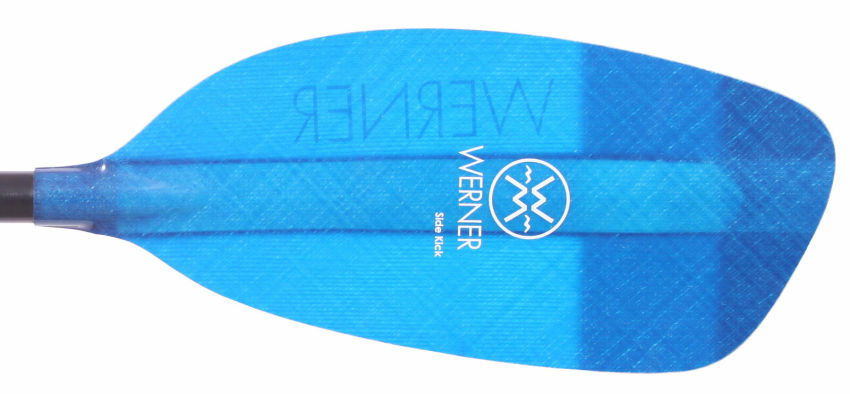
Blade size: 111 sq. in. / 719 sq. cm
Blade measurements: 19 x 8 in. / 48 x 20.75 cm
Blade material: fiberglass
1-piece straight shaft
Lengths: 191 cm / 194 cm / 197 cm / 200 cm / 203 cm
Weight: 35.5 oz. / 1006 g
Feather angles: 30° right-handed / 45° right-handed
4-piece straight shaft
Lengths: 194 cm / 197 cm / 200 cm / 203 cm / 206 cm / 209 cm
Weight: 41.5 oz. / 1177 g.
Feather angles: 30° right and left-handed / 45° right and left-handed and 0°
1-piece bent shaft
Lengths: 191 cm / 194 cm / 197 cm / 200 cm / 203 cm
Weight: 38 oz. / 1077 g
Feather angles: 30° right-handed / 45° right-handed
Designed for playboaters, where direct, immediate power and a high stroke rate are of utmost importance, Werner Side Kick’s downturned blades are ridiculously powerful and enormously playful. These paddles were designed alongside their smaller counterpart, the Player, for those ripping up the waves or throwing trips downriver.
Beyond playboaters, the Side Kicks have become enormously popular Werner paddle among paddlers who love their instant catch and effortless release, these are a paddle which can maximise cadence. Features like the low profile spine and thin blades make the Side Kicks more than just a powerful paddle, though, they are a great choice for linking strokes together in tight creeks and burly rivers.
These performance blades are built to last. The fiberglass blades are thicker at the end, designed to endure the hardships of white water kayaking.
Werner Surge
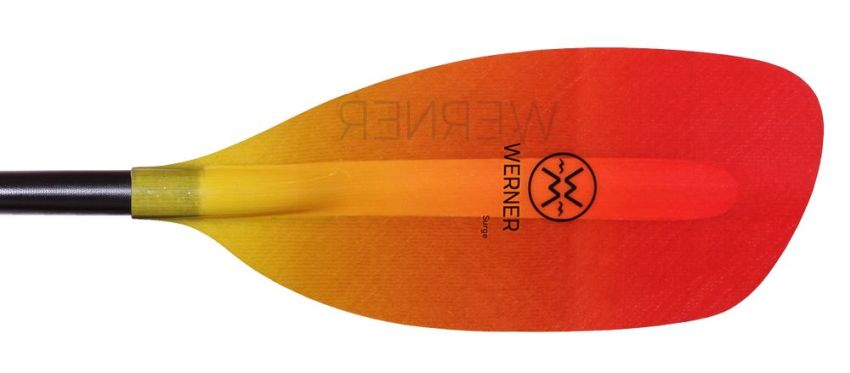
Blade size: 112 sq. in. / 725 sq. cm
Blade measurements: 19 x 8 in. / 48.25 x 20 cm
Blade material: fiberglass
One piece straight shaft
Lengths: 194 cm / 197 cm / 200 cm / 203 cm / 206 cm
Weight: 35.25 oz. / 999 g
Feather angles: 30° right-handed / 45° right-handed
Four piece straight shaft
Lengths: 194 cm / 197 cm / 200 cm / 203 cm / 206 cm / 209 cm
Weight: 41.25 oz. / 1169 g
Feather angles: 30° right and left-handed / 45° right and left-handed and 0°
One piece bent shaft
Lengths: 194 cm / 197 cm / 200 cm / 203 cm
Weight: 37.75 oz. / 1070 g
Feather angles: 30° right-handed / 45° right-handed
The Surge is one of Werner’s most recent, bomb-proof paddles, tested by expedition paddlers around the world, in some of the most demanding environments. The offset design has been enhanced on the Surge, which maximises the vertical phase through the water, giving you a smoother catch and release. This enhanced power phase gives you scope to get the most out of every paddle stroke, where it really matters.
These newest paddles in Werner’s range have had their flex optimised, so that on long expedition paddling trips you can rely on the power and solid feel of these blades, without straining your body. This is an all round blade, equally at home sending boof strokes off big drops, or linking moves together in demanding, big water environments.
The Surge is the larger model in this range, which also includes two smaller models, the Strike and the Spark. Those are ideal for paddlers with a smaller frame or who prefer a slightly less powerful blade.
Werner Stikine
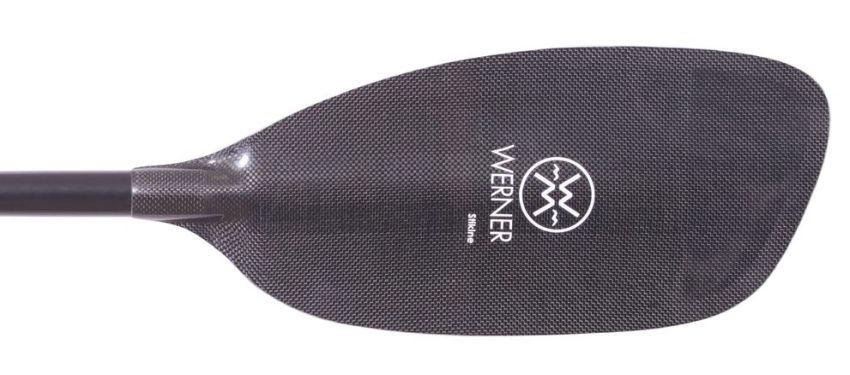
Blade size: 101 sq. in. / 656 sq. cm.
Blade measurements: 18 x 7.5 in. / 46 x 19 cm
Blade material: Carbon with foam core
1-piece straight shaft
Lengths: 191 cm / 194 cm / 197 cm / 200 cm
Weight: 34.25 oz. / 971 g
Feather angles: 30° right-handed / 45° right-handed
1-piece bent shaft
Lengths: 191 cm / 194 cm / 197 cm / 200 cm
Weight: 36.75 oz. / 1042 g
Feather angles: 30° right-handed / 45° right-handed
The Grand Canyon of the Stikine, in Canada, sets the mark for demanding, walled in grade five white water. Big rapids and demanding environments call for the best and the Werner Stikine paddle delivers high power strokes and effortless linked strokes, so you can focus on the line ahead.
Carbon, foam core blades sit buoyant in the water, giving you a slightly smoother release phase so you can up your cadence and build momentum in tight corridors. This also makes rolling in aerated, churning water far easier, so you spend more time the right way up.
Combining carbon blades with Werner’s bombproof fiberglass shafts optimises the flex on these paddles, protecting your body over long days of paddling. Meanwhile, protective edges on the blades, Dynel edges and kevlar reinforcement, puts any worries of carbon’s fragility to the back of your mind.
Best Paddles for Whitewater Kayakers: Factors to Consider
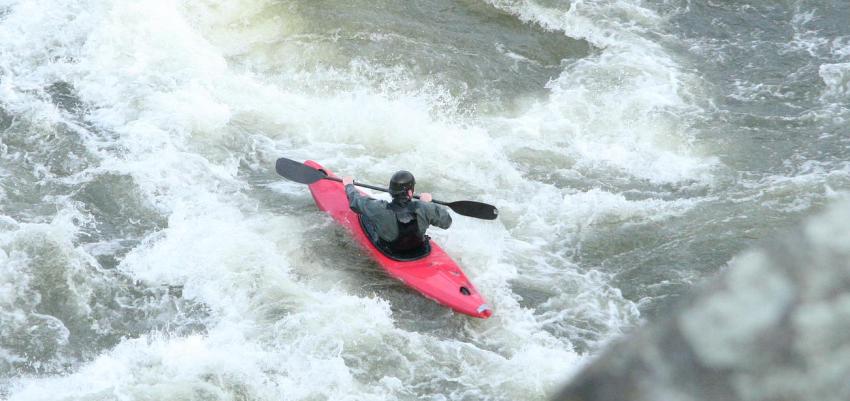
What type of white water kayaking will you do?
This is a good starting point because it will dictate everything else about your paddle choice. Before you can commit to your perfect paddle, you need to think about what sort of paddler you want to be.
Playboating/Freestyle Kayaking
Playboating, also known as freestyle kayaking, is a discipline that involves throwing tricks and dynamic moves. Playboating usually happens on a wave, or in a hole where the water recirculates. The moves involve cartwheeling, looping, and pirouetting the kayak on end, all while remaining on the wave.
River Running
River running is a broad term that covers most aspects of downstream kayaking. River running involves linking keystrokes in rapids and negotiating white water.
Steep Creeking
Steep creeking is a specific type of river running. The clue is in the name, but steep creeks are narrow places, full of waterfall drops and tight lines. This is a highly technical discipline and often there is no room for mistakes.
Paddle Length: What Size Of Kayak Paddle Is Best
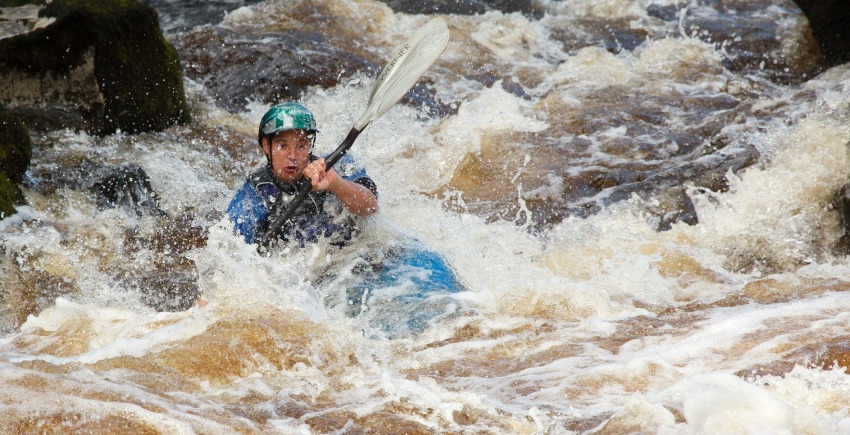
Playboating/Freestyle Kayaking
Playboating is maybe the most obvious discipline to need a different paddle. The high stroke rate and need for explosive power dictate that you will want a shorter paddle with a large blade area.
A shorter paddle will allow you a higher stroke turnover, also known as cadence. These shorter paddles are favored among playboaters. Playboat paddles tend to range from 191 cm to 197 cm.
River Running / Creeking
River running requires a longer paddle. This gives you a creator catch phase of the stroke, where you first generate the power. You can achieve more with fewer strokes and buy yourself time in the rapid.
River running paddles tend to range from 194 to 200 cm. These paddles are designed for smooth, linked strokes and longer days on the water. River running paddlers help you conserve energy while paddling efficiently.
When you’re surfing a wave, or hole, you need to be as dynamic as possible. A high turnover of paddle strokes and fast stroke recovery gives you the space to turn quickly and generate power in short bursts. These bursts of power mean you can generate upstream speed to stay on the face of the wave.
You may use the detailed Werner Paddle Size Chart provided by Next Adventure as a reference when choosing the right size for your whitewater kayak paddle.
Blade Shape
We won’t get too technical here, but there are a couple of basics that go with different styles of white water kayaking. All white water kayak paddles should be asymmetric blades with a rough teardrop shape to them. They will also be high-angle blades, which give you a more direct drive and suit the narrower style of kayak.
Playboating blades have a more downturned look, with a large area below the shaft. This shape gives you a more instant engagement and recovery phase, so your dynamic movements have more instant power.
River running blades tend to have more of the area above the shaft, at the upper tip. This gives the blade a better ‘catch’ on the water, so you can generate power sooner. This lengthens the paddle, so consider these longer blades when selecting your paddle length.
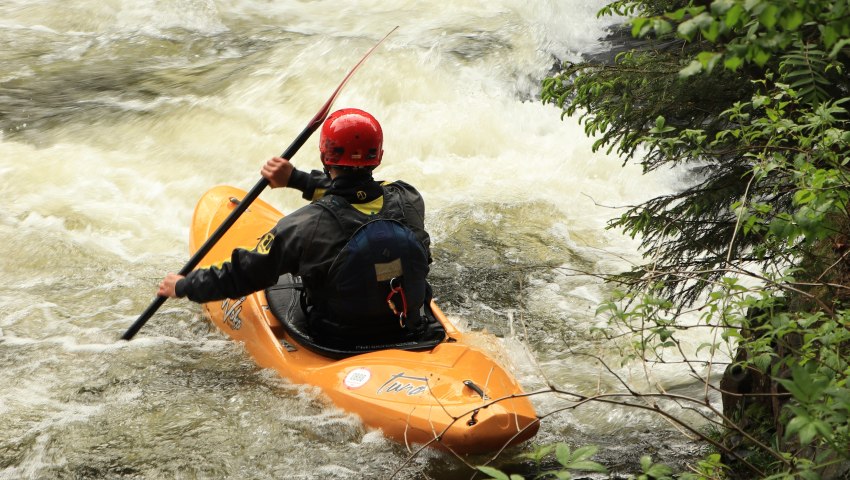
Materials: What Are Kayak Paddles Made Of?
White water kayak paddles need to be robust. The power of the water alone can break paddles, not to mention the rocks that you will inevitably bash as you paddle.
They need to be powerful and responsive, though. It’s a balancing act of having an efficient paddle without having one which won’t survive the trip.
Aluminum
Very few white water kayak paddles use aluminum. It’s heavier and less responsive than fiberglass shafts. Aluminum may still be found on some recreational level white water paddles, but if you are serious about progressing, fiberglass is the way to go.
Plastic
Many introductory white water paddles use nylon kayak blades. Plastic blades are robust, withstanding rocks far better than other types of paddle blades. Most kayak schools around the world will use plastic paddle blades.
These blades are usually reinforced with fiberglass to stiffen them. This makes them responsive enough to make moves and generate power. Plastic blades will always have some flex to them though, which loses some power and limits feedback to the paddler.
Fiberglass
If you watch any major white water film, you will probably see the paddlers using fiberglass paddles. Fiberglass is by far the most popular material for both the shaft and blades.
Fiberglass shafts are responsive enough that you get a lot of feedback and response from them. They also retain enough flex that you can use them comfortably on long days.
Fiberglass blades are used for a very similar reason. They are mid-range in terms of price, but solid enough to withstand rocks. Over time, you will chip away at the fiberglass and notice your blade getting smaller, but you have to use your paddle a lot for this to happen.
Fiberglass blades are powerful and stiff. They give a good level of catch and instant power without fluttering in the water.
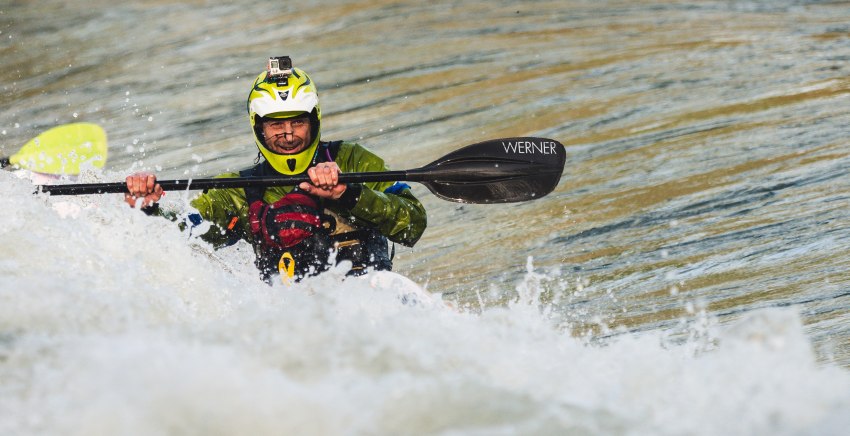
Carbon
Carbon paddles are the most expensive and stiffest paddles on the market. The blades are essentially a more responsive and lighter version of fiberglass paddle blades. They are also weaker, though, and if you use them on really rocky rivers, you will see them deteriorate quickly.
Some carbon blades have a foam or air core to them. This helps the paddle float above aerated water for extra power and a quicker Eskimo roll. If these are punctured, though, the paddle is useless.
Carbon shafts are extremely stiff. Some paddlers who don’t want to lose any power may benefit from this, but over time carbon shafts can cause issues with your wrists. For this reason, many carbon shafts come with a bent shaft option, which we will explain shortly.
Bent or straight shaft
Straight shaft paddles are familiar to most people and are easy to use. Bent shaft paddles are favored by some and are designed to protect your wrists over longer periods of use. Stiffer shafts, like carbon, are often sold in bent options to prevent repetitive strain injuries.
Bent shafts are usually more expensive and it’s up to you whether you think it’s worth the extra expense. It is worth trying a bent shaft before you buy, though, as they can feel alien at first.
Small shaft paddles
Some smaller framed paddlers could benefit from a small-shaft paddle. These are designed to fit more comfortably in smaller hands and are often coupled with less powerful blades and shorter paddles.
Feather
The angle of your blades is less important among white water paddles than it is for sea kayakers. This is more of a personal preference than an energy-saving measure.
White water paddles are available between 0° and 45°. Most people, though, opt for around 30°. This is a matter of personal preference.
One-piece or split paddles
Split paddles have a place in whitewater kayaking. That place is usually a spare pair of paddles that sit in the back of your boat in case you break your main paddle.
One-piece paddles are stronger than split paddles, and white water paddlers should prioritize strength. However, if you plan to travel to your paddling destination and storage space is limited, a split paddle can be a viable choice. Many new systems are almost as strong as one-piece paddles.

